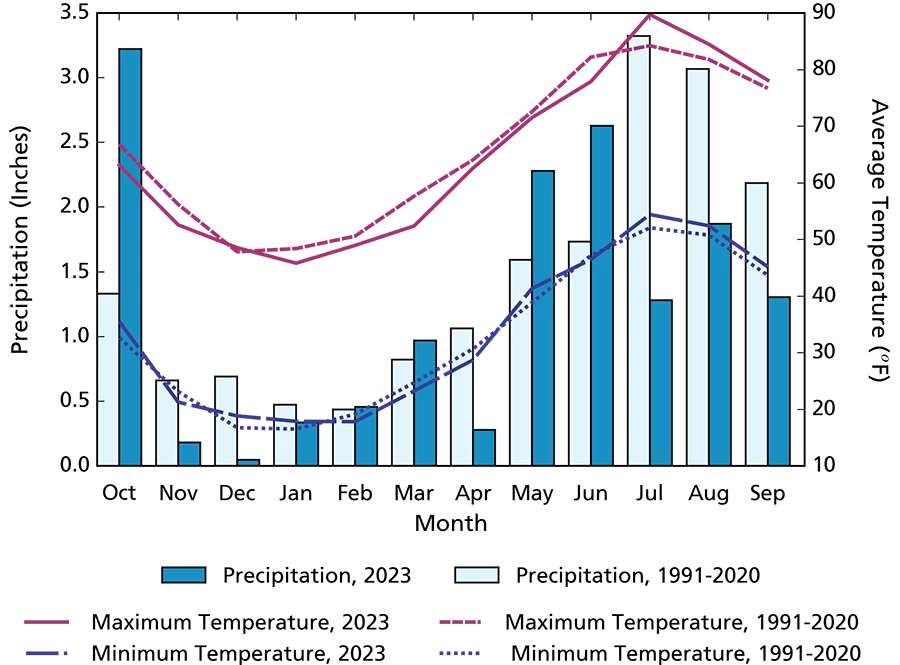Last updated: September 10, 2025
Article
Climate and Water Monitoring at Fort Union National Monument: Water Year 2023

NPS
Overview
Together, climate and hydrology shape ecosystems and the services they provide, particularly in arid and semi-arid ecosystems and across the Southern Plains (Woodhouse and Overpeck 1998). Understanding changes in climate, groundwater, and surface water is key to assessing the condition of park natural resources—and often, cultural resources.
At Fort Union National Monument (Figure 1), Southern Plains Inventory and Monitoring Network scientists study how ecosystems may be changing by taking measurements of key resources, or “vital signs,” year after year—much as a doctor keeps track of a patient’s vital signs. This long-term ecological monitoring provides early warning of potential problems, allowing managers to mitigate them before they become worse. At Fort Union National Monument, we monitor climate and groundwater, among other vital signs.
Groundwater conditions are closely related to climate conditions. Because they are better understood together, we report on climate in conjunction with water resources. Reporting is by water year (WY), which begins in October of the previous calendar year and goes through September of the water year (e.g., WY2023 runs from October 2022 through September 2023). This article reports the WY2023 climate and groundwater monitoring results for Fort Union National Monument.
Reference: Woodhouse, C. A., and J. T. Overpeck. 1998. 2000 years of drought variability in the central United States. Bulletin of the American Meteorological Society 79(12): 2693–2714. https://doi.org/10.1175/1520-0477(1998)079%3C2693:YODVIT%3E2.0.CO;2

NPS
Climate and Weather
There is often confusion over the terms “weather” and “climate.” In short, weather describes instantaneous meteorological conditions (e.g., it’s currently raining or snowing, it’s a hot or frigid day). Climate reflects patterns of weather at a given place over longer periods of time (seasons to years). Climate is the primary driver of ecological processes on earth. Climate and weather information provide context for understanding the status or condition of other park resources.
Methods
The closest weather station to Fort Union National Monument is 19 miles (31 km) away. As a substitute, climate analyses in this report use current year and 30-year averages (1991–2020) of gridded surface meteorological (GRIDMET) data located at the Fort Union National Monument Visitor Center.
GRIDMET is a spatial climate dataset at a 4-kilometer resolution that is interpolated using weather station data, topography, and other observational and modeled land surface data. Temperature and precipitation estimated from GRIDMET may vary from actual weather at a particular location, depending on the availability of weather station data and the difference in elevation between the location of interest and that assigned to a grid cell. Data from the weather station 19 miles from the park and GRIDMET are available through Climate Analyzer.

NPS
Results for Water Year 2023
Precipitation
Annual precipitation at Fort Union National Monument in WY2023 was 14.85″ (37.7 cm), 2.53″ (6.4 cm) less than the 1991–2020 annual average. The October precipitation total was nearly 2.5 times the 1991–2020 average (Figure 2). November and December were much drier than average. Precipitation during the winter and spring months (January–June) were near or above average, except for April, which was substantially drier. The summer months (July–September) were moderately drier than average.
Air Temperature
The mean annual maximum temperature at Fort Union National Monument in WY2023 was 64.7°F (18.2°C), 1.1°F (0.6°C) below the 1991–2020 average. The mean annual minimum temperature in WY2023 was 33.7°F (0.9°C), 0.6°F (0.3°C) above the 1991–2020 average. Mean monthly maximum and minimum temperatures in WY2023 differed by as much as 5.5°F (3.0°C; see March as an example) relative to the 1991–2020 monthly averages (Figure 2). Mean monthly maximum temperatures were generally cooler than average from October through June, while mean monthly minimum temperatures were more variable. Mean maximum and minimum temperatures from July through September were warmer than average.

NPS
Drought
Reconnaissance drought index (Tsakiris and Vangelis 2005) provides a measure of drought severity and extent relative to the long-term climate. It is based on the ratio of average precipitation to average potential evapotranspiration (the amount of water loss that would occur from evaporation and plant transpiration if the water supply was unlimited) over short periods of time (seasons to years). The reconnaissance drought index for Fort Union National Monument indicates that WY2023 was drier than the 1991–2023 average from the perspective of both precipitation and potential evapotranspiration for the fourth consecutive year (Figure 3).
Reference: Tsakiris G., and H. Vangelis. 2005. Establishing a drought index incorporating evapotranspiration. European Water 9: 3–11.

NPS

NPS
Groundwater
Groundwater is one of the most critical natural resources of the American Southwest, providing drinking water, irrigating crops, and sustaining rivers, streams, and springs throughout the region.
Methods
Fort Union National Monument groundwater is monitored using one well, WL-0257 (Figure 1). The New Mexico Bureau of Geology and Mineral Resources began monitoring the well in 2022. The data are available at the Healy Collaborative Groundwater Monitoring Network.
Results for Water Year 2023
The groundwater level in the well, measured once in WY2023, was 98.51 feet below ground surface (ft bgs; 30.02 m bgs) on 08 August 2023 when the well was recently pumped (Table 1 and Figure 4). Monitoring started in WY2022, and the first three measurements indicate that water level can be variable during the year. Additional data will be needed to better understand normal fluctuations.
Table 1. Groundwater monitoring results in water year 2023 (WY2023), Fort Union National Monument (amsl = above mean sea level; bgs = below ground surface).
| State Well Number | Location | Wellhead Elevation (ft amsl) |
Mean Depth to Water (ft bgs) |
Mean Water Level Elevation (ft amsl) |
Change in Elevation from WY2022 (± ft) |
|---|---|---|---|---|---|
| WL-0257 | Fort Union NM | 6,719.00 | 98.51 | 6,620.49 | −0.56 |

NPS
Report Citation
Authors: Kara Raymond, Andy Ray
Raymond, K., and A. Ray. 2024. Climate and Water Monitoring at Fort Union National Monument: Water Year 2023. Southern Plains Network, National Park Service, Pecos, New Mexico.
